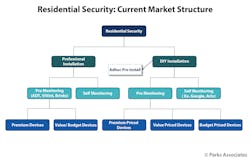The Smart Money: The Evolution of Residential Security
This article originally appeared in the April 2022 issue of Security Business magazine. When sharing, don’t forget to mention Security Business magazine on LinkedIn and @SecBusinessMag on Twitter.
Historically, the residential security market has struggled to exceed 25% of broadband households owning a system. Starting in 2018, product innovations, new entrants, and diversifying business models that give consumers more choice have resulted in definitive market growth.
COVID-19 has been a net driver for the security industry, as the uncertainty of this time aided interest in products and services that provide consumers with peace of mind. Improved DIY systems are another reason for growth.
Security and home systems have been established for decades in specific consumer segments, but now connectivity has created new opportunities. For the security market, market factors are creating new dynamics and a new structure for smart home and home security players:
1. Affordability
2. Commoditization vs. Differentiation
3. Consolidation / Partnerships
4. Disintermediation
5. Smart Home Integration
Security adoption continues solid growth with 90% of adopting households opting for professional monitoring. That is a higher rate of pro monitoring than witnessed in many years. Of even greater significance is the change in method of installation from majority professional installation to a majority of buyers going DIY, as Parks Associates research reports that more than half of buyers in 2020 and 2021 self-installed systems.
Additionally, the high percentage (41%) of subscribers intending to switch providers is startling and must be of concern to providers.
DIY Security Systems have gained steam over the past five years, with COVID-19 acting as an accelerant. While residential security integrators report lower units selling per month since 2019, consumers report higher adoption than ever. DIY security systems have improved their ease of installation and available adjacencies such as smart door locks and cameras with the integration work already done by the system manufacturer. DIY system manufacturers provide professional monitoring as an option and fees are lower than most national providers like ADT and Comcast/Xfinity. Professional monitoring remains a critical component of a consumer perceiving the home to be safe.
It is evident that the uncertainty of the pandemic aided interest in products and services that provide consumers with peace of mind. The research firm reveals that most providers have shown a positive growth trend as of Q3 2021 and self-installation increased from 40% in Q4 2018 to 53% in Q2 2021.
In recent years, the penetration of home security systems has experienced meaningful growth. Traditional residential security players continue to integrate advanced technologies, especially around AI and video analytics, to create new service offerings, address new customer segments, and integrate with Google and Amazon. These new advances and innovative products are helping redefine residential security services and expanding them into new areas. Consumer choice regarding installation, device bundles, and monitoring services is a driving force for both professional and DIY solutions.
Broadening consumer adoption of smart home products through retail, traditional home security system providers, and ISPs creates an onboarding ramp to the development of new professional services—or added revenue to existing services.
Elizabeth Parks is President and CMO of market research firm Parks Associates. For more information on the residential security market, the adoption of home security systems and services visit www.parksassociates.com or download the complimentary whitepaper Value Beyond Home Security: Expanding Product Ecosystems, in collaboration with Alarm.com, at https://online.flippingbook.com/view/163648901.
About the Author

Elizabeth Parks
Elizabeth Parks is the President of market research firm Parks Associates. For more information, visit www.parksassociates.com
